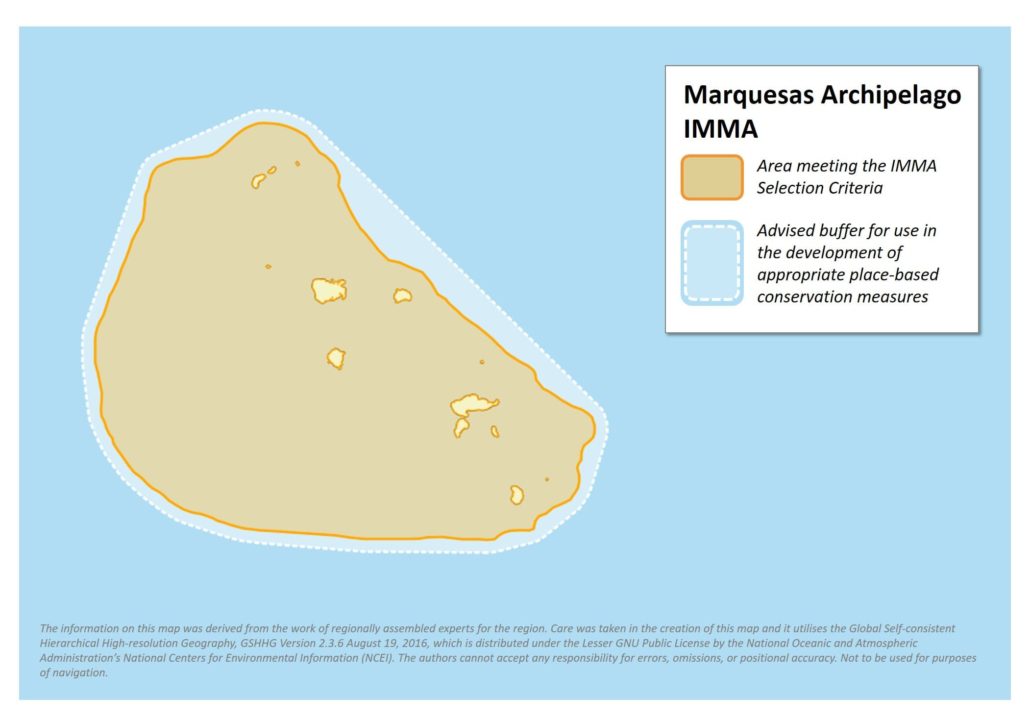Marquesas Archipelago IMMA
Area Size
100 460 km2
Qualifying Species and Criteria
Melon-headed whale – Peponocephala electra
Criterion B (2); D (1)
Spinner dolphin – Stenella longirostris
Criterion D (1)
Marine Mammal Diversity
Criterion D (2)
Physeter macrocephalus, Megaptera novaeangliae, Mesoplodon densirostris, Lagenodelphis hosei, Kogia sima, Ziphius cavirostris, Globicephala macrorhynchus, Pseudorca crassidens, Feresa attenuata, Orcinus orca, Stenella attenuata, Steno bredanensis, Tursiops truncatus, Grampus griseus
Download fact sheet
Summary
Marine mammal aerial and small-boat surveys in the Marquesas Archipelago have revealed an unusually rich area in terms of cetacean diversity (minimum of 16 species confirmed) and abundance, in comparison to other regions of the South Pacific. The IMMA encompasses coastal and pelagic waters surrounding all the islands of the Marquesas archipelago, extending offshore to the west to include an area of higher density for pelagic species. The IMMA is also includes nearshore habitat used regularly by genetically distinct aggregations of melon-headed whales that show predictable and unusual behaviour throughout the archipelago.
Description of Qualifying Criteria
Criterion B: Distribution and Abundance
Sub-criterion B2: Aggregations
Large groups (up to several hundreds) of melon-headed whales are seen aggregating on a daily basis very close to the shore around most of the main islands of the archipelago within the IMMA. Over 6,000 dorsal fin photographs collected among 14 melon-headed whales’ groups at four islands (Mohotani, Ua Huka, Ua Pou, and Nuku Hiva) in the IMMA were analysed. A total of 393 distinctively marked individuals were identified. Based on these data, the minimum abundance of melon-headed whales in the Marquesas Islands was estimated at about 1,800 individuals using the Lincoln-Petersen, two-sample, mark-recapture model (McClung 2017; Poole et al. 2013).
Criterion D: Special Attributes
Sub-criterion D1: Distinctiveness
The unusual use of coastal habitat by Melon-headed whales in the Solomon’s during daytime is a distinctive behavioural/ecological feature of the IMMA. Furthermore, preliminary mtDNA analyses have shown genetic structuring of Melon-headed whales inhabiting the waters of Mohotani, compared to those that occur around the northern islands of Nuku Hiva, Ua Huka and Ua Pou (Baker, unpublished), i.e. within the IMMA. Melon-headed whales are usually described as pelagic and therefore their regular occurrence in coastal waters of the Marquesas is noteworthy, although it’s important to note, that aggregations of this species have also been reported at Palmyra atoll (Brownell et al., 2009) and Mayotte (Kiszka et al., 2011). Therefore, although unusual, this behaviour is not necessarily unique. However, the fact these aggregations happen simultaneously at several islands of the same archipelago is unmatched to our knowledge.
Genetic analyses (mtDNA sequencing and microsatellite genotyping) have shown that spinner dolphins from the Marquesas are genetically distinct from other populations in the Pacific (Oremus et al. 2007, Baker Unpublished report; Baker 2015). In addition, Oremus et al (2007) found clear genetic differentiation between spinner dolphins in the Marquesas and Society Islands.
Sub-criterion D2: Diversity
All dedicated cetacean surveys conducted in the Marquesas so far have confirmed a high diversity of cetacean species (16 species) in the IMMA (Gannier et al., 2002, Laran et al,. 2012, Poole et al., 2013). Gannier et al. (2002) recorded a total of 154 groups of odontocetes on-effort in the Marquesas, including ten delphinids species (S. attenuata, S. longirostris, T. truncatus, P. electra, S. bredanensis, G. macrorhynchus, P. crassidens, F. attenuata, G. griseus and O. orca). In April-May 2011, Laran et al. (2012) conducted aerial surveys across the Marquesas archipelago, resulting in the identification of 11 species. Finally, Poole et al. (2013), despite concentrating their effort only in coastal/nearshore waters, identified 7 cetacean species during small boat surveys in April 2012.
Supporting Information
Baker, C.S. 2015. A pattern of dolphins (aPOD) – the seascape genetics of island populations in protected and unprotected habitats of Oceania. Unpublished report to Pew Marine Conservation Fellowship.
Brownell, R. L., Ralls, K., Baumann-Pickering, S., and Poole, M.M. 2009. Behavior of melon headed whales, Peponocephala electra, near oceanic islands. Marine Mammal Science, 25(3), 639–658. https://doi.org/10.1111/j.1748-7692.2009.00281.x
Gannier, A. 2009. Comparison of odontocete populations of the Marquesas and Society Islands (French Polynesia). Journal of the Marine Biological Association of the UK 89(5): 931–941.
Gannier, A. 2002. Distribution of Cetaceans off the Marquesas Islands (French Polynesia) as obtained from a small boat dedicated survey. Aquatic Mammals, 28(2): 198-210.
Kiszka, J., Simon-Bouhet, B., Martinez, L., Pusineri, C., Richard, P. and Ridoux, V. 2011. Ecological niche segregation within a community of sympatric dolphins around a tropical island. Marine Ecology Progress Serie, 433: 273−288.
Laran, S., Van Canneyt, O., Dorémus, G., Massart, W., Ridoux, V. and Watremez, P. 2012.Distribution et abondance de la mégafaune marine en Polynésie française. REMMOA- Polynésie. Rapport final pour l’Agence des Aires Marines Protégées (in French).
Laran, S., Van Canneyt, O., Poole, M. and Oremus, M. 2016. – Mammifères marins des Marquises. 137-158 (Eds R. Galzin, S.-D. Duron and J. Y. Meyer). Biodiversité terrestre et marine des îles Marquises, Polynésie française. Société Française d’Ichtyologie, Paris.
Mannocci, L., Catalogna, M., Dorémus, G., Laran, S., Lehodey, P., Massart, W., Monestiez, P., Van Canneyt, O., Watremez, P. and Ridoux, V. 2014. Predicting cetacean and seabird habitats across a productivity gradient in the South Pacific gyre. Progress in Oceanography, 120: 383-398.
McClung, J.R. 2017. Photo-identification of Melon-headed whales (Peponocephala electra) in the Marquesas Islands: Creation of the first photo-identification catalogue and estimation of group size and minimum abundance in a remote archipelago. Oregon State University, Ms Thesis.
Oremus, M., Poole, M., Steel, D. and Baker, C.S. 2007. Isolation and interchange among insular spinner dolphin communities in the South Pacific revealed by individual identification and genetic diversity. Marine Ecology Progress Series, 336: 275-289.
Poole, M., Oremus, M., Albertson, R. and Baker, C.S. 2013. Expedition Marquesas: Photo-identification surveys and biopsy sampling of small cetaceans in northern French Polynesia, Report (SC/65/SM09) submitted to the Scientific Committee of the International Whaling Commission, Jeju, Republic of Korea.


